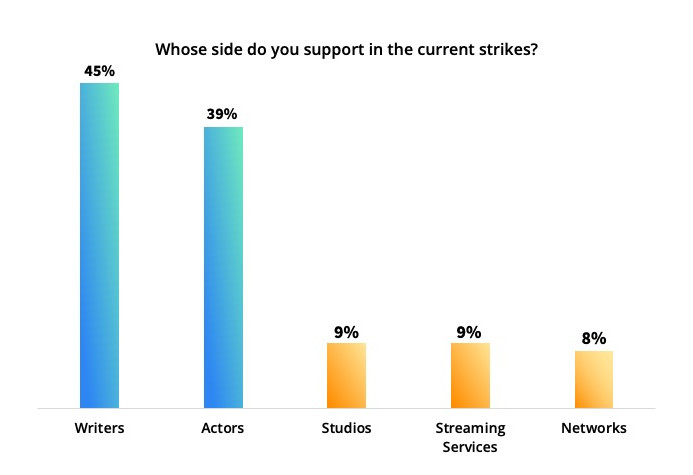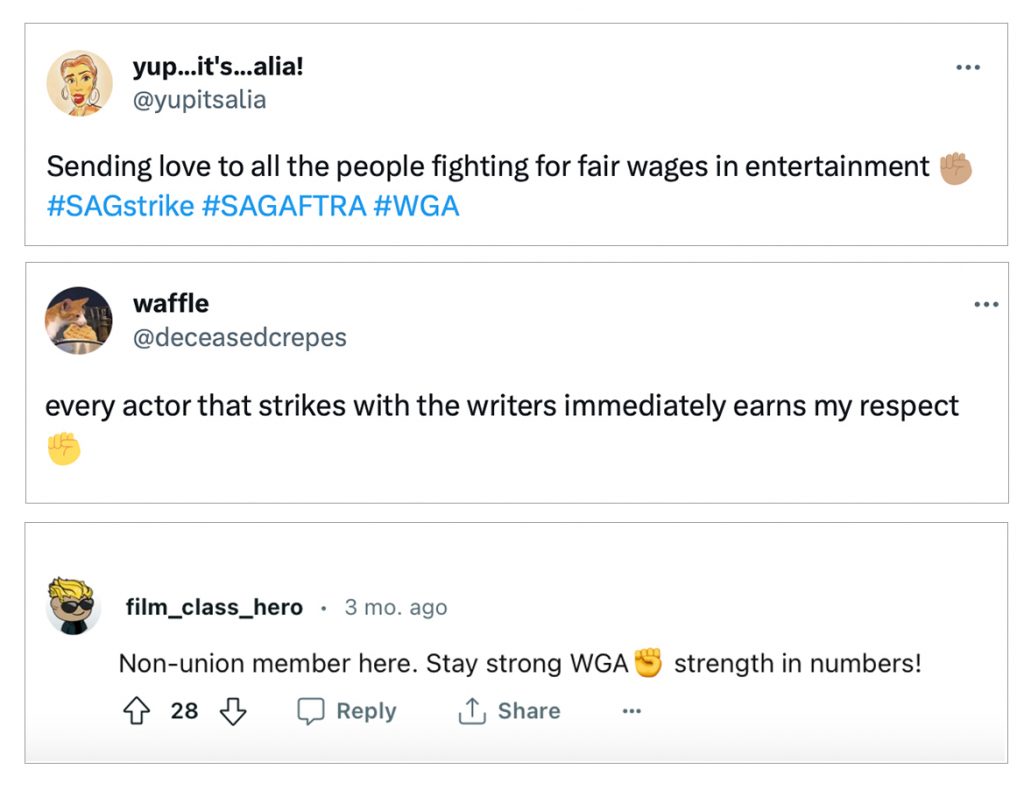Social is rewriting the playbook on sports engagement for the Olympics and beyond.
WGA + SAG-AFTRA Strikes: Awareness and Viewing Behavior
Summary
On Friday, July 14th, the Screen Actors Guild (SAG-AFTRA) announced they would go on strike after they were unable to come to a contract resolution with the Alliance of Motion Picture and Television Producers (AMPTP) over issues including compensation from streaming and the use of AI technology. This move, combined with the already-on-strike Writers Guild of America (WGA), is creating a large-scale work stoppage that will have a widespread impact on both the industry beyond the striking writers and actors, as well as on viewers nationwide. Horizon Media’s WHY Group surveyed 600 people and analyzed social conversation to see how many people are aware of the strikes, how they feel about them and how they might change their viewing behaviors as a result.
Volume & Sources
In the 72 hours following the announcement of the SAG strike, there were 1.1 million related social posts and nearly 800k social posts in the 72 hours following the WGA strike announcement. The SAG Strike conversation also reignited the WGA strike conversation since they were now happening in tandem. While conversation has subsided since the initial spikes, there is a sustained volume of interest due to overall awareness and investment in the outcome.

Source: NetbaseQuid 4/30/2023 – 7/28/2023
People are Aware and Invested
To gauge overall awareness of the two strikes, we asked respondents about their level of familiarity with a number of recent labor-related disputes. Over half of those we surveyed were aware of the WGA strike (52%) and SAG strike (58%) – 11+ pts more than any other high-profile labor dispute (UPS, Amazon, Starbucks, etc.) Not only are people aware, but they’re invested. Nearly three in four (73%) say they care and are following the story, likely because they realize that striking writers and actors will mean a glut of reality shows and reruns:
- “The strike will hold up the new fall TV shows. Guess I will be watching reruns and reality. The strike is a big blow to many economies.”
- “It will impact the filming of current and new scripted content, leading to more low-quality “reality” TV.”
- “I am unclear on how writers and actors are paid for their work, but I expect to have no new episodes of the Fallon, Colbert & Kimmel late shows, and other original entertainment programs, until the parties reach a mutually acceptable update.”
Whose Side Are You On, Anyway?
In our current cultural climate, there’s increasing awareness of and tension around the wage gap between workers and executives. In 2021, the gap reached an all-time high of 399:1, an increase from 2020’s 366:1 and a far cry from 1965’s 20:1 (Source: Statista). We’ve shifted away from admiring the wealthy and aspiring to be them or be like them, to criticizing the ethics involved in large-scale wealth-building. Given this, it’s perhaps not surprising to find people largely on the side of the striking writers (45%) and actors (39%) and not the studios (9%), Networks (8%) or Streaming Services (9%).

Source: Horizon Media’s Finger on the Pulse. Survey Fielded July 18-19; n=600
In social conversation, the raised fist emoji with over 53k posts is the most popular emoji used in conversation about the strikes and is used to show solidarity with the striking workers:

When we dig a little deeper into qualitative conversation around the WGA and SAG strikes, there’s a bit of perception that actors are rich and part of the problem, and garner less sympathy:

What’s a Viewer To Do?
We asked people what they would do if their favorite scripted shows were unavailable for an extended period of time. Their overall responses are below, with most people claiming they’ll rewatch old shows. Luckily, there is a lot of existing content to watch and it might even nudge people to dig a little deeper into the existing libraries on streaming platforms they already subscribe to.
For those 35-49, subscribing to a new platform in order to get access to new-to-them content seems more appealing (+7pts). Younger viewers are more likely to pause their subscriptions until new content returns (+10pts) or turn to the social media platforms that are already stealing them away (+22pts). People 50+ are more likely to do nothing different (+6pts).
Only 15% of people said they’d cancel a streaming service. People are actively being discouraged from canceling their streaming by the strikers and are being redirected to donate to funds that provide resources and aid to those in the industry who are struggling financially.

Source: Horizon Media’s Finger on the Pulse. Survey Fielded July 18-19; n=600
But the Emmys!
We recognize that the Prime-Time EMMY Awards are the unofficial kickoff to Fall TV. We asked people if they still planned to watch, knowing that the Emmys might be a little different this year. Overall, only 17% of respondents said they plan to still watch the Emmys (27% for 26-34). Nearly one-third (31%) of younger viewers 18-25 say they won’t watch out of solidarity with striking writers and actors. This is in line with what we know to be true about younger people making brand choices that align with their values: 60% of US adults 18-34 agree that brands have an obligation to act on social issues, and taking a stance is not enough (vs 53% total).*
Entertainment Choices are Important to Younger Viewers
One common point of contention among viewers is the rising costs of streaming subscriptions. Whether it’s from one platform raising its prices, or the need to subscribe to multiple platforms, the promise of streaming being a less costly alternative to traditional cable is largely gone. So we asked the uncomfortable-but-burning question: if streaming prices were to go up in order to meet the demands of striking writers and actors, would you be willing to pay more?
For roughly a quarter of total respondents (28%), that answer was “yes”. For those who support the strikers, that response increases to 38%. For younger viewers 18-25 and 26-34, the percentages increase to 46% and 41% respectively. But despite these increases — and greater support for striking workers among younger people in general — the numbers don’t suggest an overwhelming willingness to pay out of pocket to solve a problem they largely see as the responsibility of studios and networks.
Perhaps more alarming, is those least likely to pay more AND most likely to unsubscribe are viewers 35+. These numbers reflect the frustrations felt by viewers and underscore how critical it will be for entertainment companies to ensure viewers get value for their money — or risk frustrating them to the point of cancellation.

Source: Horizon Media’s Finger on the Pulse. Survey Fielded July 18-19; n=600
So What?
Based on what we’ve learned through this exploration to date, there are a few things we think brands should consider:
Streaming platforms need to make their content libraries smarter and more searchable, improving suggestion algorithms to help viewers identify library content that will appeal during what will likely be a lag in original programming. They also have the opportunity to turn the discovery journey into an entertaining game, giving viewers another reason to go deep vs. leave for other forms of entertainment.
Entertainment brands can put marketing dollars behind top shows that can still build their audience even though they aren’t coming out with new episodes right now. Streaming services who have first party data can use their recommendation engines to prompt people to go deeper into their watch lists, helping people see the value and avoid cancellations.
Knowing that younger viewers are the most likely to turn to social media channels, it’ll be important for entertainment brands to air more episodic or serialized content in bite-sized formats on these channels as a way to drive younger viewers back to the originating channel/streaming platform or make them aware of library content. For younger audiences who are more likely to spend in accordance with their values, tying any increase in subscription costs to an increase in compensation for the talent is key. For older audiences who may be hovering over the proverbial cancel button, delivering on subscription value will be key.
For more information, contact askwhy@horizonmedia.com
*Horizon Media Finger on the Pulse. Survey Fielded June 2-13; n=984




